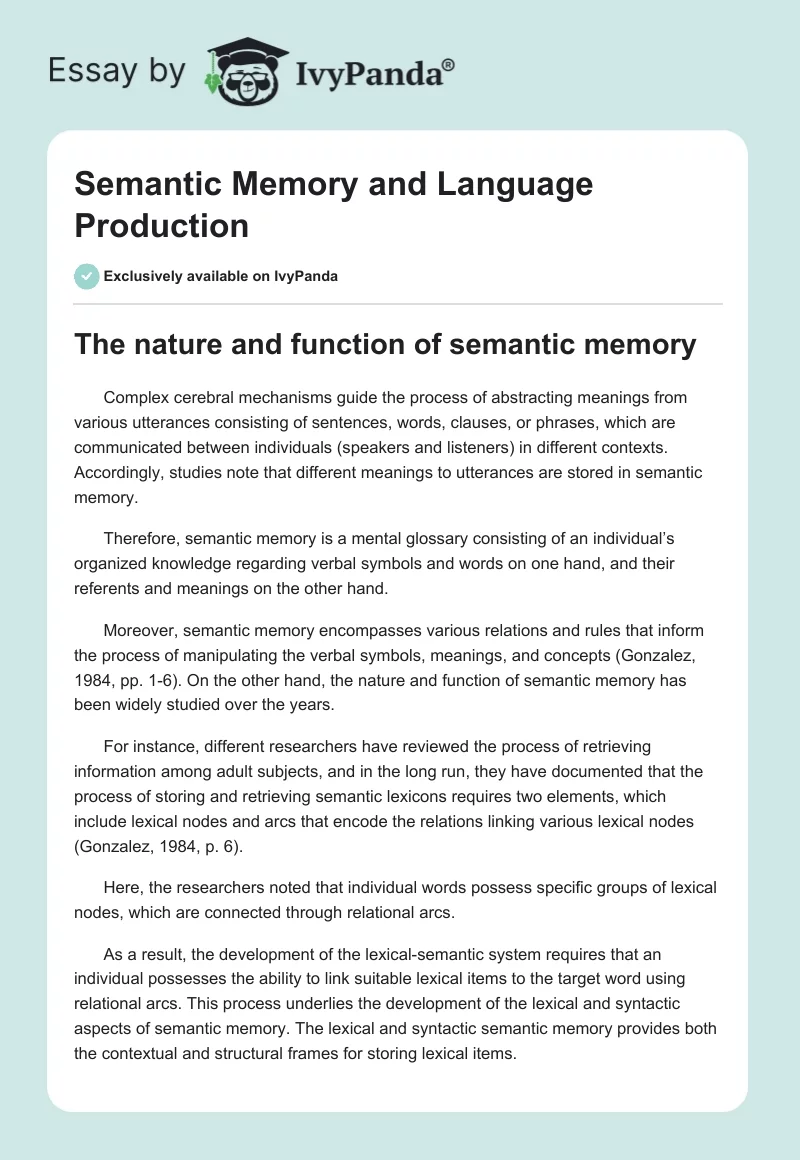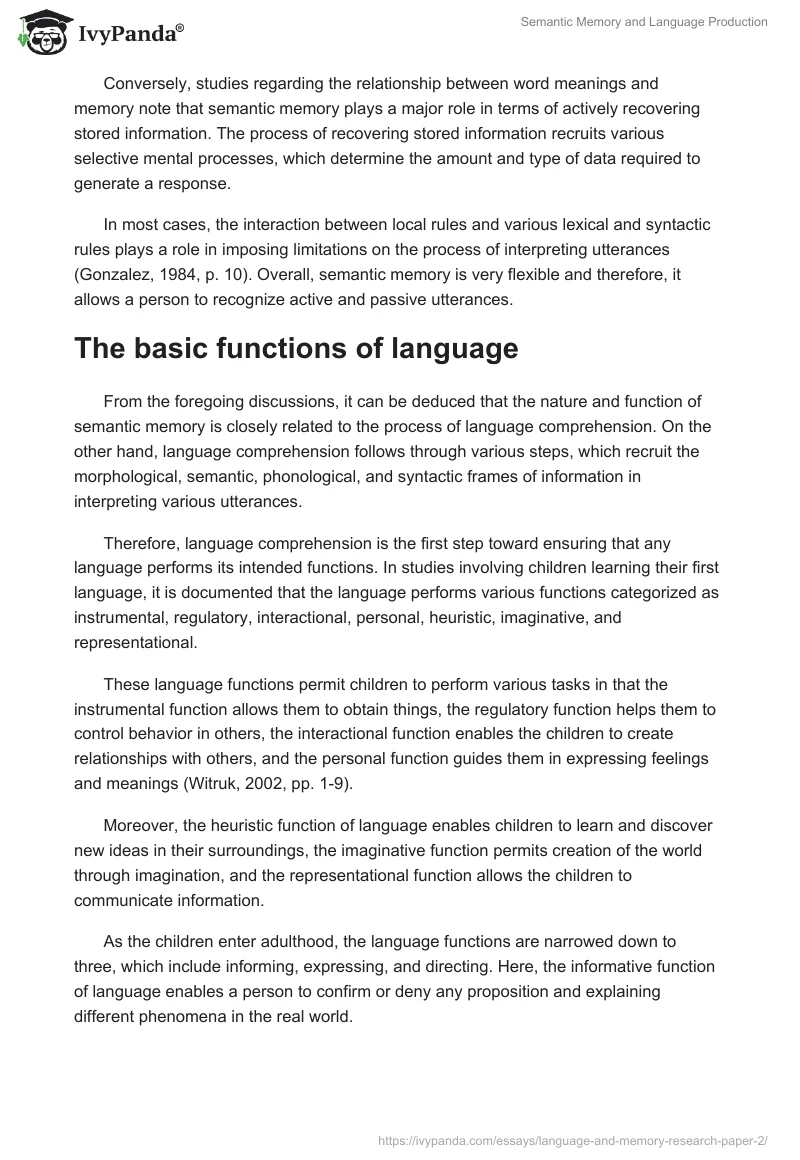The nature and function of semantic memory
Complex cerebral mechanisms guide the process of abstracting meanings from various utterances consisting of sentences, words, clauses, or phrases, which are communicated between individuals (speakers and listeners) in different contexts. Accordingly, studies note that different meanings to utterances are stored in semantic memory.
Therefore, semantic memory is a mental glossary consisting of an individual’s organized knowledge regarding verbal symbols and words on one hand, and their referents and meanings on the other hand.
Moreover, semantic memory encompasses various relations and rules that inform the process of manipulating the verbal symbols, meanings, and concepts (Gonzalez, 1984, pp. 1-6). On the other hand, the nature and function of semantic memory has been widely studied over the years.
For instance, different researchers have reviewed the process of retrieving information among adult subjects, and in the long run, they have documented that the process of storing and retrieving semantic lexicons requires two elements, which include lexical nodes and arcs that encode the relations linking various lexical nodes (Gonzalez, 1984, p. 6).
Here, the researchers noted that individual words possess specific groups of lexical nodes, which are connected through relational arcs.
As a result, the development of the lexical-semantic system requires that an individual possesses the ability to link suitable lexical items to the target word using relational arcs. This process underlies the development of the lexical and syntactic aspects of semantic memory. The lexical and syntactic semantic memory provides both the contextual and structural frames for storing lexical items.
Conversely, studies regarding the relationship between word meanings and memory note that semantic memory plays a major role in terms of actively recovering stored information. The process of recovering stored information recruits various selective mental processes, which determine the amount and type of data required to generate a response.
In most cases, the interaction between local rules and various lexical and syntactic rules plays a role in imposing limitations on the process of interpreting utterances (Gonzalez, 1984, p. 10). Overall, semantic memory is very flexible and therefore, it allows a person to recognize active and passive utterances.
The basic functions of language
From the foregoing discussions, it can be deduced that the nature and function of semantic memory is closely related to the process of language comprehension. On the other hand, language comprehension follows through various steps, which recruit the morphological, semantic, phonological, and syntactic frames of information in interpreting various utterances.
Therefore, language comprehension is the first step toward ensuring that any language performs its intended functions. In studies involving children learning their first language, it is documented that the language performs various functions categorized as instrumental, regulatory, interactional, personal, heuristic, imaginative, and representational.
These language functions permit children to perform various tasks in that the instrumental function allows them to obtain things, the regulatory function helps them to control behavior in others, the interactional function enables the children to create relationships with others, and the personal function guides them in expressing feelings and meanings (Witruk, 2002, pp. 1-9).
Moreover, the heuristic function of language enables children to learn and discover new ideas in their surroundings, the imaginative function permits creation of the world through imagination, and the representational function allows the children to communicate information.
As the children enter adulthood, the language functions are narrowed down to three, which include informing, expressing, and directing. Here, the informative function of language enables a person to confirm or deny any proposition and explaining different phenomena in the real world.
Conversely, the expressive function of language involves expressing feelings and attitudes by the speakers and evoking emotions among the listeners. Finally, the directive function of language enables the speaker to cause or prevent overt actions among the listeners. This function is widely employed in giving commands and requests (Witruk, 2002, pp. 11-15).
The Stages of Language Production
Language production is the process through which various word meanings are constructed and expressed. This process follows a series of steps including construction, transformation, and execution. In the stage of construction, communication goals related to word meanings are selected using selective mental processes followed by the identification of suitable meanings.
Subsequently, the transformation phase of language production entails the application of various local rules and lexical/syntactical rules in transforming the identified word meanings into messages. These messages are then expressed in form of audible or observable actions in the execution phase of language production (O’Malley & Chamot, 1990, p. 37).
Relative to language comprehension, the stages of language production are also subject to the influence of mental processes. For instance, the construction phase of language production begins with the speaker or writer setting communication goals, which are in turn converted into facts on the basis of an existing body of knowledge incorporating the semantic memory.
Consequently, the next step after setting goals and facts entails restructuring the facts using various knowledge discourses and sociolinguistic rules. In the transformation phase, the restructured facts are converted into meaningful expressions or sentences (O’Malley & Chamot, 1990, p. 40).
Here, the incoming information or facts are subdivided into various meaningful units, which can only be expressed in the presence of certain limiting conditions. For instance, writing occurs after the writer has converted the plans and intentions into meaningful mental representations (sentences or sentence fragments).
Conversely, the execution phase is the final step in language production considering that it entails the work of the hand and mouth. For example, various mental representations of information or facts can be communicated through writings or speeches (O’Malley & Chamot, 1990, p. 45).
Semantic Memory and Language Production
The relationship between semantic memory and language production has been a subject of interest for many researchers over the years. This follows the proposition that when a person produces a word, the underlying process entails selection of suitable lexical concepts from a variety of other concepts, which are also active in the mental lexicon (semantic memory).
The proposition arises from studies regarding speech errors conducted in the 1970s and 1980s. The current studies regarding the nature of language production and processing systems employ various paradigms to investigate the process of semantic retrieval during language production. The most widely used model entails the picture-word interference (PWI) in which participants are expected to name pictures in the presence of superimposed words on the pictures.
The printed words on the pictures serve as distractors, which cannot be ignored by the participants during the naming process. As a result, studies document that the semantic relationship between the picture and word influences the naming latencies.
For example if the word and picture fall into the same semantic relationship, the participants will take a longer time to name the picture than otherwise. Here, researchers note that the word increases the semantic competition, and thus, prolonging the reaction time.
Similar studies have been conducted relative to word access, semantic activation, and activation of phonological codes with the results showing that lexical retrieval embeds the process of language production, and that, lexical retrieval particularly from the frontal and temporal cortices is subject to various influences including distractors.
Moreover, lexical retrieval of the semantic memory and phonological facilitation are imperatives in language production (Spalek & Thompson-Schill, 2008, pp. 1-9).
References
Gonzalez, J. (1984). Semantic theory, comprehension, and bilingualism. Education Resources Information Center. Web.
O’Malley, J.M., & Chamot, A.U. (1990). Learning strategies in second language acquisition. New York: Cambridge University Press.
Spalek, K., & Thompson-Schill, S.L. (2008). Task-dependent semantic interference in language production: An fMRI study. Brain and Language, xxx (xx), 1-9. Web.
Witruk, E. (2002). Neuropsychology and cognition: Basic functions of language, reading, and reading disability. Norwell, Massachusetts: Kluwer Academic Publishers.


